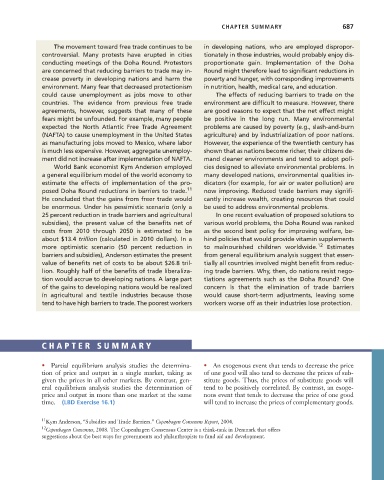Page 713 - Microeconomics, Fourth Edition
P. 713
c16GeneralEquilibriumTheory.qxd 8/16/10 9:14 PM Page 687
CHAPTER SUMMARY 687
The movement toward free trade continues to be in developing nations, who are employed dispropor-
controversial. Many protests have erupted in cities tionately in those industries, would probably enjoy dis-
conducting meetings of the Doha Round. Protestors proportionate gain. Implementation of the Doha
are concerned that reducing barriers to trade may in- Round might therefore lead to significant reductions in
crease poverty in developing nations and harm the poverty and hunger, with corresponding improvements
environment. Many fear that decreased protectionism in nutrition, health, medical care, and education.
could cause unemployment as jobs move to other The effects of reducing barriers to trade on the
countries. The evidence from previous free trade environment are difficult to measure. However, there
agreements, however, suggests that many of these are good reasons to expect that the net effect might
fears might be unfounded. For example, many people be positive in the long run. Many environmental
expected the North Atlantic Free Trade Agreement problems are caused by poverty (e.g., slash-and-burn
(NAFTA) to cause unemployment in the United States agriculture) and by industrialization of poor nations.
as manufacturing jobs moved to Mexico, where labor However, the experience of the twentieth century has
is much less expensive. However, aggregate unemploy- shown that as nations become richer, their citizens de-
ment did not increase after implementation of NAFTA. mand cleaner environments and tend to adopt poli-
World Bank economist Kym Anderson employed cies designed to alleviate environmental problems. In
a general equilibrium model of the world economy to many developed nations, environmental qualities in-
estimate the effects of implementation of the pro- dicators (for example, for air or water pollution) are
posed Doha Round reductions in barriers to trade. 11 now improving. Reduced trade barriers may signifi-
He concluded that the gains from freer trade would cantly increase wealth, creating resources that could
be enormous. Under his pessimistic scenario (only a be used to address environmental problems.
25 percent reduction in trade barriers and agricultural In one recent evaluation of proposed solutions to
subsidies), the present value of the benefits net of various world problems, the Doha Round was ranked
costs from 2010 through 2050 is estimated to be as the second best policy for improving welfare, be-
about $13.4 trillion (calculated in 2010 dollars). In a hind policies that would provide vitamin supplements
more optimistic scenario (50 percent reduction in to malnourished children worldwide. 12 Estimates
barriers and subsidies), Anderson estimates the present from general equilibrium analysis suggest that essen-
value of benefits net of costs to be about $26.8 tril- tially all countries involved might benefit from reduc-
lion. Roughly half of the benefits of trade liberaliza- ing trade barriers. Why, then, do nations resist nego-
tion would accrue to developing nations. A large part tiations agreements such as the Doha Round? One
of the gains to developing nations would be realized concern is that the elimination of trade barriers
in agricultural and textile industries because those would cause short-term adjustments, leaving some
tend to have high barriers to trade. The poorest workers workers worse off as their industries lose protection.
CHAPTER SUMMAR Y
• Partial equilibrium analysis studies the determina- • An exogenous event that tends to decrease the price
tion of price and output in a single market, taking as of one good will also tend to decrease the prices of sub-
given the prices in all other markets. By contrast, gen- stitute goods. Thus, the prices of substitute goods will
eral equilibrium analysis studies the determination of tend to be positively correlated. By contrast, an exoge-
price and output in more than one market at the same nous event that tends to decrease the price of one good
time. (LBD Exercise 16.1) will tend to increase the prices of complementary goods.
11 Kym Anderson, “Subsidies and Trade Barriers.” Copenhagen Consensus Report, 2004.
12 Copenhagen Consensus, 2008. The Copenhagen Consensus Center is a think-tank in Denmark that offers
suggestions about the best ways for governments and philanthropists to fund aid and development.

